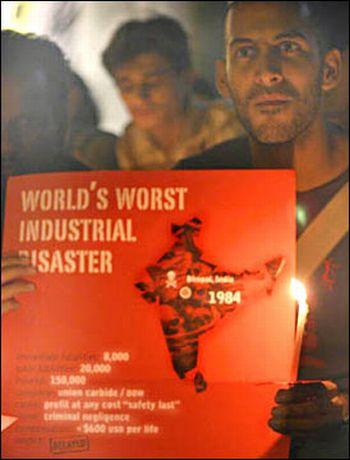 | « Back to article | Print this article |
Not learning from Bhopal
 We have no protocol for handling chemical accidents, managing medical relief or fixing the liability of polluters.
We have no protocol for handling chemical accidents, managing medical relief or fixing the liability of polluters.
It's been 25 years since the night when chemicals spewed out of the Union Carbide factory in Bhopal to kill and maim thousands over generations. The question is if we have learnt from the disaster -- learnt how to handle a chemical accident; to dispose of industrial toxic waste; to manage crucial medical relief, to give monetary compensation speedily and to establish the liability of polluters -- so that accidents like this do not happen again.
I was in Bhopal this week as the city observed the anniversary of that night. An exhibition put up by Bhopal activists made spectators relive that night of horror: How people just fell to the ground like flies, instantly dead as the gas-ridden air hit them; how the carcasses of thousands of animals lay rotting on the roads and how hospitals could not cope with the victims, and how they (particularly the company) refused to explain the ailment or offered treatment.
What is worse is that even today parts of the city still live in horror. Activists say that the next generation, children born after the disaster to parents of gas victims, is unusually deformed and diseased. Worse still, a stockpile of toxic chemicals remains in the factory -- leaching and contaminating groundwater of the new and old victims of this industrial disaster.
The question is why this continues to happen. The fact is we refuse to use credible public science to guide policy. After the disaster, the Indian Council of Medical Research was asked to study the short-term and long-term medical implications of the chemicals.
But in the early 1990s, the government asked the institution to discontinue the research, without assigning any reason. As a result, there is no epidemiological research on the victims, old and new.
Civil society groups working with victims have published studies on the increased incidence of mental and physical deformities among the gas-affected population. But as there is no empirical research by government institutions, the government can deny the problem exists. It is poverty they say, nothing unusual, criminal and irresponsible.
We stumbled on this denial game on another connected issue -- the disposal of waste in the Union Carbide factory compound. For some years now, groups working in Bhopal have raised concern that toxic contaminants remain in the factory.
A case has been filed in the Jabalpur bench of the Madhya Pradesh high court to direct the government to remove the waste and remove it quickly. For the past two years or so, the central and state government's have been dealing rather unsuccessfully with the question of how to dispose of the waste -- will it be sent to landfill sites, or will it be incinerated? But even as it grapples with these questions, the stockpile of some 340 tonnes of stored waste sits on the abandoned factory. And the government decides to change tack.
It now says the waste is not toxic and that groundwater around the factory is not contaminated. Why? Because its scientific institutions say so. My colleagues at the Centre for Science and Environment decided to investigate.
They did the following: They first investigated what the factory was manufacturing and what were the processes that it used. This gave them clues into what should be checked in the laboratory.
Piecing together scanty information, they learnt that Union Carbide manufactured three kinds of pesticides -- carbaryl (trade name Sevin); aldicarb (Temik) and a formulation of carbaryl and gamma-hexachlorocyclohexane (g-HCH), sold under the trade name Sevidol.
The company bought technical grade HCH and after extraction of g-HCH, threw the waste with remaining isomers and lasting toxicity into the ground. They also looked at the derivatives of the chemicals; the solvents used by the company like chlorinated benzene and heavy metals like mercury used as sealants in the company.
With this information, we asked for permission to collect samples. We got it readily from the Union Minister for Environment and Forests and officials of the pollution control board accompanied my colleagues to the factory.
Chandra Bhushan, who directed this research, says that he was shocked to see traces of mercury visible in parts of the factory. He then went to different sites around the factory, collecting groundwater sample: To know if the pollution had spread.
The results were startling. We found the same chemicals in the soil and water of the factory, at unacceptably high levels; we found the same in groundwater almost 3 km from the city, though at lower levels but signifying chronic toxicity, long-term exposure to which can lead to deadly diseases, particularly in an already immuno-suppressed poor population of gas victims.
Also, the task of remediation is massive -- not just the stored waste but the soil and water will also need to be cleaned.
But science is malleable. Studies used by the state government to say that there was no or negligible danger, only discussed acute toxicity -- the amount a human being would need to consume to die. Then, the studies, which showed no contamination of groundwater, did not even check for the pesticides being produced by the factory.
They did not find any, because they did not check for what needed to be found. Confusion and denial are the names of the game. The victims will be forgotten till the next anniversary comes along.
Image: A protestor at a candle-lit vigil on the 25th anniverary of the Bhopal Gas Tragedy | Photograph: Jewella C Miranda
